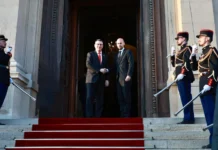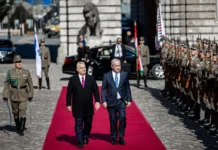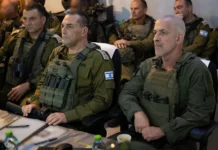During last Saturday’s early hours, when the attention of most Israelis was focused on politics and election-related matters, enormous blasts rocked a suspected Iranian surface-to-surface missile factory on the outskirts of the town of Masyaf, in northwest Syria. Satellite imagery showed that an entire complex had been destroyed.
International media reports attributed the attack to the Israel Air Force, and Israeli Prime Minister Benjamin Netanyahu, speaking a day afterwards, stated that “we are continuing to operate on all fronts, including the northern one.” He added, “We are not prepared to allow someone to entrench themselves in a way that endangers Israel.”
The incident is a reminder that Iran and its radical terrorist axis are continuing attempts to build up their attack capabilities against Israel in Syria, just as they are in other areas.
Assuming Israel was indeed behind the Masyaf attack, it likely responded to urgent intelligence of threatening activity at the site—possibly the conversion of rockets into precision ballistic missiles—a threat Israel has declared repeatedly that it would not tolerate.
It is also possible that Iran’s Islamic Republic Guards Corps (IRGC) tried to take advantage of the fact that Israel is in between governments, testing Jerusalem’s ability to order decisive military preventative strikes during a sensitive political time in the country.
If this was the reasoning behind the IRGC’s activities at Masyaf, its gamble failed to pay off. The targeted facility is in a region filled with suspicious sites related to the Iranian and Assad regime missile production and research program, according to Israeli satellite company ISI. Other sites, linked to Iran’s surface-to-surface missile project in Syria, have been attacked there in recent years.
The incident is the latest reminder that the new Israeli government will have no honeymoon period when it comes to dealing with Iran and its proxies in the region.
Already, following the U.S. designation of the IRGC as a terrorist entity on April 8, some have assessed that Iran is likely to intensify proxy attacks on Israel from Syria and from Gaza in response.
In the Gaza Strip, Palestinian Islamic Jihad (PIJ), the second largest armed faction in Gaza and Iran’s direct proxy, has built up an arsenal of rockets that now surpasses that of Hamas, the largest terrorist faction in the Strip.
PIJ’s domestic rocket manufacturing sites in Gaza have benefited directly from Iranian know-how and funding.
PIJ has been rebuilding its firepower since the 2014 conflict it and Hamas fought with Israel. Today PIJ and Hamas have a combined rocket arsenal of more than 20,000 projectiles, some of which have sufficient range to reach targets north of Tel Aviv, as a March rocket strike on an Israeli home, injuring seven civilians, demonstrated.
PIJ’s fighting force of 10,000 armed operatives, combined with Hamas’s 30,000 armed-wing members, mean that Gaza has developed a terrorist army. Together, these Iranian-funded factions threaten to indiscriminately fire rockets at Israeli civilian neighborhoods.
Israel Defense Forces units captured two PIJ operatives who had crossed over from Gaza on March 8, as they approached the fields of a southern Israeli kibbutz armed with grenades and knives.
The IDF captured the terrorists minutes before they reached Kibbutz Erez—an incident that underlines just how tangible the Iranian proxy threat from Gaza is.
The fact that PIJ is now headed by a new leader, Ziad Nakhleh, who travels back and forth between Syria and Iran, and who is extremely close to the Iranian leadership, means the PIJ will be an ever-willing Iranian proxy, prepared to do Tehran’s terrorist bidding.
As a result, the IDF has been on high alert to such threats, including the possibility of PIJ sniper fire from Gaza, and bombing attacks. Israeli security sources were quoted in media reports April 1 saying that PIJ was planning an imminent terrorist attack on Israel from Gaza. Citing suspicious activity by PIJ members, the officials said the attack could have taken the form of an anti-tank guided missile firing at Israeli military forces, a large-scale IED attack on the border, or a terror cell intrusion into Israel.
The attack did not materialize, possibly due to the release of that intelligence information, but the reports are one more illustration of how Iranian-backed terrorist forces can destabilize the region with ease.
Ultimately, Iran wishes to keep Israel busy around its borders with proxy threats, on the defensive, and deterred. Israel’s defense establishment appears to have proven in recent days that no matter what the political situation in Israel, it stands alert and ready to act against developing Iranian-backed terror threats.
Nevertheless, the Syrian and Gazan arenas will be worth watching in the coming weeks, for Tehran has shown no intention of backing away from its commitment to build up and activate bases of attack against Israel.
Iran’s activities are not, unfortunately, limited to these areas, as a recent warning by Israel’s Counter-Terrorism Bureau noted. According to the advisory, Europe also faces a threat. The advisory, in effect for April and May, states: “Iran and front members on its behalf are continuing to act to build terrorist infrastructure—mainly against ‘regime opponents’ in Europe – [yet] in line with an Iranian decision, this infrastructure could also be used for terrorist attacks against Israeli targets.”
Yaakov Lappin is a military and strategic affairs correspondent for JNS. He also conducts research and analysis for defense think tanks, and is the Israel correspondent for IHS Jane’s Defense Weekly. His book, The Virtual Caliphate, explores the online jihadist presence.


























